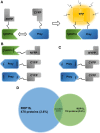Genome-Wide Bimolecular Fluorescence Complementation-Based Proteomic Analysis of Toxoplasma gondii ROP18's Human Interactome Shows Its Key Role in Regulation of Cell Immunity and Apoptosis
- PMID: 29459857
- PMCID: PMC5807661
- DOI: 10.3389/fimmu.2018.00061
Genome-Wide Bimolecular Fluorescence Complementation-Based Proteomic Analysis of Toxoplasma gondii ROP18's Human Interactome Shows Its Key Role in Regulation of Cell Immunity and Apoptosis
Abstract
Toxoplasma gondii rhoptry protein ROP18 (TgROP18) is a key virulence factor secreted into the host cell during invasion, where it modulates the host cell response by interacting with its host targets. However, only a few TgROP18 targets have been identified. In this study, we applied a high-throughput protein-protein interaction (PPI) screening in human cells using bimolecular fluorescence complementation (BiFC) to identify the targets of Type I strain ROP18 (ROP18I) and Type II strain ROP18 (ROP18II). From a pool of more than 18,000 human proteins, 492 and 141 proteins were identified as the targets of ROP18I and ROP18II, respectively. Gene ontology, search tool for the retrieval of interacting genes/proteins PPI network, and Ingenuity pathway analyses revealed that the majority of these proteins were associated with immune response and apoptosis. This indicates a key role of TgROP18 in manipulating host's immunity and cell apoptosis, which might contribute to the immune escape and successful parasitism of the parasite. Among the proteins identified, the immunity-related proteins N-myc and STAT interactor, IL20RB, IL21, ubiquitin C, and vimentin and the apoptosis-related protein P2RX1 were further verified as ROP18I targets by sensitized emission-fluorescence resonance energy transfer (SE-FRET) and co-immunoprecipitation. Our study substantially contributes to the current limited knowledge on human targets of TgROP18 and provides a novel tool to investigate the function of parasite effectors in human cells.
Keywords: ROP18; Toxoplasma gondii; bimolecular fluorescence complementation; genome-wide; human interactome.
Figures







Similar articles
-
TgROP18 targets IL20RB for host-defense-related-STAT3 activation during Toxoplasma gondii infection.Parasit Vectors. 2020 Aug 7;13(1):400. doi: 10.1186/s13071-020-04251-7. Parasit Vectors. 2020. PMID: 32767999 Free PMC article.
-
Toxoplasma gondii ROP18 inhibits human glioblastoma cell apoptosis through a mitochondrial pathway by targeting host cell P2X1.Parasit Vectors. 2019 Jun 4;12(1):284. doi: 10.1186/s13071-019-3529-1. Parasit Vectors. 2019. PMID: 31164145 Free PMC article.
-
Host Cell Vimentin Restrains Toxoplasma gondii Invasion and Phosphorylation of Vimentin is Partially Regulated by Interaction with TgROP18.Int J Biol Sci. 2017 Sep 5;13(9):1126-1137. doi: 10.7150/ijbs.21247. eCollection 2017. Int J Biol Sci. 2017. PMID: 29104504 Free PMC article.
-
Toxoplasma gondii Modulates the Host Cell Responses: An Overview of Apoptosis Pathways.Biomed Res Int. 2019 Apr 4;2019:6152489. doi: 10.1155/2019/6152489. eCollection 2019. Biomed Res Int. 2019. PMID: 31080827 Free PMC article. Review.
-
The secreted kinase ROP18 defends Toxoplasma's border.Bioessays. 2011 Sep;33(9):693-700. doi: 10.1002/bies.201100054. Epub 2011 Jul 20. Bioessays. 2011. PMID: 21773979 Free PMC article. Review.
Cited by
-
Discovery of potent anti-toxoplasmosis drugs from secondary metabolites in Citrus limon (lemon) leaves, supported in-silico study.Sci Rep. 2025 Jan 3;15(1):624. doi: 10.1038/s41598-024-82787-9. Sci Rep. 2025. PMID: 39753625 Free PMC article.
-
Prediction of Toxoplasma gondii virulence factor ROP18 competitive inhibitors by virtual screening.Parasit Vectors. 2019 Mar 13;12(1):98. doi: 10.1186/s13071-019-3341-y. Parasit Vectors. 2019. PMID: 30867024 Free PMC article.
-
Strain-specific disruption of interferon-stimulated N-myc and STAT interactor (NMI) function by Toxoplasma gondii type I ROP18 in human cells.Parasitology. 2020 Nov;147(13):1433-1442. doi: 10.1017/S0031182020001249. Epub 2020 Jul 30. Parasitology. 2020. PMID: 32729455 Free PMC article.
-
Preparation and Preliminary Application of Epitope Peptide-Based Antibody against Toxoplasma gondii GRA3.Trop Med Infect Dis. 2023 Feb 27;8(3):143. doi: 10.3390/tropicalmed8030143. Trop Med Infect Dis. 2023. PMID: 36977144 Free PMC article.
-
An integrated analysis of hypoxic-ischemic encephalopathy-related cell sequencing outcomes via genes network construction.Ibrain. 2022 Mar 15;8(1):78-92. doi: 10.1002/ibra.12025. eCollection 2022 Spring. Ibrain. 2022. PMID: 37786415 Free PMC article.
References
Publication types
MeSH terms
Substances
LinkOut - more resources
Full Text Sources
Other Literature Sources
Medical

